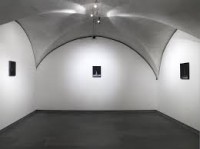By Mackenzie Constantinou (Lorenzo de’ Medici)
The staff dedicated to Francesco Gennari, an artist born in Pesaro in 1973 and among the most important in Italy of his generation, closes the exhibition program ‘Late on Morning’ curated by Alberto Salvadori.
The exhibit recalls the works, which express the will of the artist to represent not only the sensible world but also that, which is not visible, and in particular, through the great amount of self-portraits, Gennari tries to satisfy the desire to represent interiority.
The first sculpture that the visitor meets on the descent into the crypt is titled ‘I want to be myself, but only in the light of the sun’, and is displayed in the center of the room, isolated, and made more focal thanks to overhead lights that is itself an integral part of the work.
The artist expresses the same through transparent glass that maybe refers precisely to the impossibly of representing that which cannot be seen and that which is changing.
The glass switches to the strong valence material of marble, in the ‘Self-Portrait in the Study’ Gennari divided one smooth marble block of essential form. Immediately the visitors were attracted by the successive works, which changes the register and returns the declined transparency to a bright yellow.
The last work in that first space, ‘Degeneration of Parsifal’, underlines though the continuous change of language in the art of artists creates a Persaro explosion of material.
The exhibition has explanatory sheets that are in both English and Italian which continue with another self-portrait. A dark compact structure but with an octagonal form and therefore complex and multifaceted still returns a different artist.
Continuing to go to the second series of works, ‘Having themselves as the only reference point’ the subject of the photography is a sail that makes explicit the title of works. This refers to the symbolism of a shell and the concept of the centrality of the viewpoint. The same animal is also the protagonist of the next sculpture titled ‘Ascension’, and it is not surprising that the viewers must climb three steps to enter the chapel of the crypt where it is preserved, here the fragile shells of four snails support the heavy black material.
The last group of works, all photographic self-portraits hung on the walls of the room, shows the figure of the artist as soon as the visitor feels that emerge from the darkness.
Gennari represented same emersion into darkens in his coat the Universe, now transcends the origin of it, symbolizing by a blue panel, now different parts of night of the universe that is both internal and external.
The last work ‘The earth turns its back to the sun’ displayed in the Renaissance chapel Rucellani is again a reference to the universe, and to the concept of centrality and of life that results in the egg in the center of the sculpture.
Francesco Gennari, Museo Marino Marini
By Carolina Caverni (University of Florence)
La personale dedicata a Francesco Gennari, artista nato a Pesaro nel 1973 e tra i più importanti in Italia della sua generazione, chiude il programma espositivo “Late on morning” curato da Alberto Salvadori.
La mostra raccoglie le opere che più esprimono la volontà dell’artista di rappresentare non solo il mondo sensibile ma anche ciò che non è visibile, e in particolare, attraverso la grande quantità di autoritratti, Gennari tenta di soddisfare l’anelito di raffigurare la propria interiorità.
La prima scultura che si incontra scendendo nella cripta, intitolata “Vorrei essere me stesso ma solo alla luce del sole”, è esposta al centro della stanza, isolata, e resa ancor più focale grazie alla luce zenitale che fa essa stessa parte integrante dell’opera.
L’artista qui esprime se stesso attraverso la trasparenza del vetro che rimanda forse proprio a quell’impossibilità di rappresentare ciò che non si vede e che è mutevole.
Dal verto si passa alla forte valenza materica del marmo, in “Autoritratto nello studio” Gennari diviene un blocco marmoreo dalla forma essenziale e liscia, ma subito lo spettatore viene attratto dall’opera successiva in cui si cambia registro e si torna alla trasparenza declinata in un giallo brillante.
Ultima opera in questo primo spazio, “La degenerazione di Parsifal”, sottolinea ancora il continuo cambio di linguaggio nell’arte dell’artista pesarese che crea un’ esplosione di materia.
Il percorso espositivo, segnalato in fogli esplicativi volanti sia in inglese che in italiano, prosegue con un altro autoritratto; una struttura scura compatta ma con la forma dell’ottagono e dunque anche complessa e sfaccettata restituisce una natura ancora diversa dell’artista.
Proseguendo si passa alla seconda serie di opere, in “Avendo se stessi come unico punto di riferimento” il soggetto della fotografia è una lumaca che rende esplicito il titolo dell’opera rimandando al simbolismo del guscio e al concetto della centralità del punto di vista. Lo stesso animale è protagonista anche della scultura successiva intitolata “Ascensione”, e non a caso lo spettatore deve salire tre scalini per accedere al sacello della cripta dove è conservata, qui i fragili gusci di 4 lumache sorreggono la pesante materia nera.
Ultimo nucleo di opere, tutti autoritratti fotografici appesi alle pareti della sala, mostrano la figura dell’artista che appena si intuisce mentre affiora dalle tenebre.
Gennari rappresenta se stesso immerso nel buio ora ospitando nel suo cappotto l’Universo, ora trascinando l’origine di esso, simboleggiato da un panno blu, ora diventando parte stessa della notte e di nuovo di un universo che è nello stesso tempo interiore ed esteriore.
L’ultima opera “ La terra gira le spalle al sole” è esposta nella rinascimentale cappella Rucellai e di nuovo è un rimando all’universo, al concetto di centralità e di vita che si concretizzano nell’uovo al centro della scultura.
